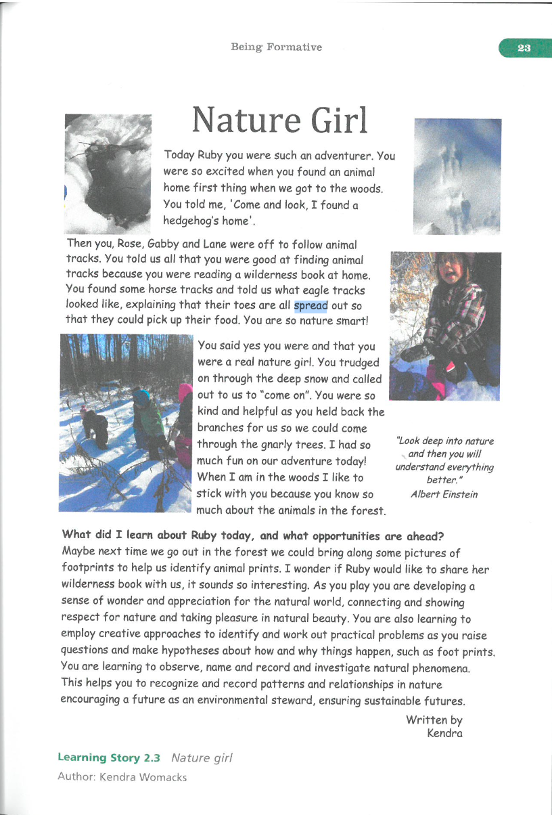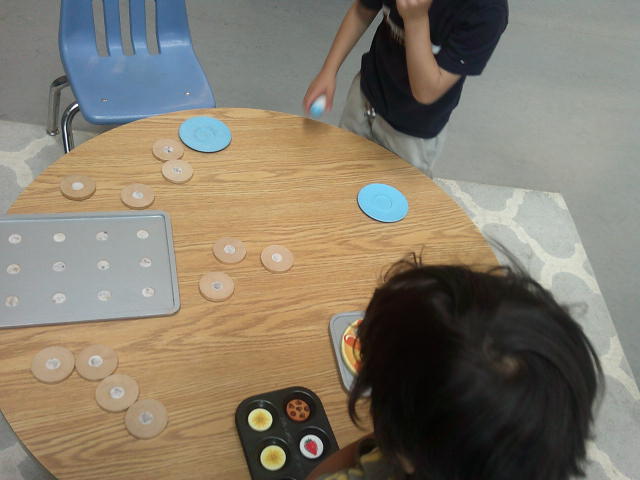This section is where students collect observations, pedagogical process, curriculum choices, implementation, documentation, reflection, and notes as they create environments and experiences with children indoors/outdoors. Students will refer to:
- ECED 1200
- ECED 1350
- BC Early Learning Framework (2019) Section 2
- Living Inquiries (BC ELF, 2019)
Pedagogical documentation (Pedagogical Narration) is a creative process and there are many ways to design and document what you, staff, children and programs are exploring. The following examples may help you plan your Pedagogical Documentation space.
Example: Learning Stories in Practice (Carr & Lee, 2019)
Example: Josie’s Drips
Josies-DripExample: Mapping
Mapping-Place-Oct-13-web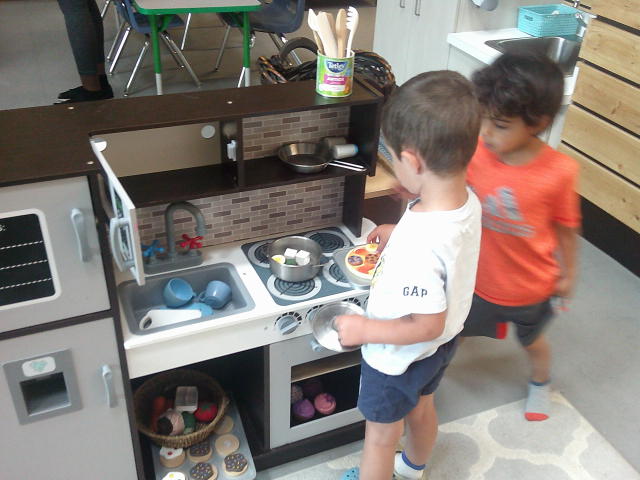
Learning Portfolio Entry – Day 1
Date: July 7, 2025
Willows Room, Cariboo Childcare Society
This photo captured a lively moment in the dramatic play area. Three children were gathered around the toy kitchen, “cooking breakfast.” One child was stirring an empty pot with a plastic spoon, while another was flipping pretend pancakes on a toy frying pan. When I asked them what they were making, they shouted together: “PANCAKES!”
The children’s imaginative play was rich and full of social interaction. They assigned roles, one was the cook, another the server, and a third child was the “mommy” who ordered food. They used utensils, plates, and even placed food on a tray to serve. I noticed they negotiated turn-taking and took care of “safety” in the play kitchen, pretending the stove was hot and reminding each other to “be careful.” This type of play extended for nearly 20 minutes, and new children joined and left without disrupting the flow.
This experience demonstrated to me the significant impact of dramatic play on multiple areas of early learning. The children were developing communication skills, social collaboration, and early numeracy (e.g., counting pancakes or cups). I was reminded that when we step back and simply observe, children reveal complex thinking through play.
This moment also demonstrated the value of following children’s interests. I did not direct the activity but instead supported it by asking thoughtful questions like, “How do you know when the pancakes are ready?” This encouraged deeper thinking and language use.
It helped me reflect on being a co-learner with children, rather than a director. It made me curious about how I can revisit this play later, perhaps by bringing in real pancake ingredients for sensory play or adding recipe cards for emergent literacy.
I asked one of the educators: “Is it okay to let them play without correcting or stepping in, even when they mix up kitchen tools?”
She replied, “Absolutely. We let the play flow because it’s about imagination, not accuracy. If you step in too much, it interrupts their creativity. But if safety becomes a concern, that’s when we gently intervene.”
This reassured me that imaginative freedom supports deeper learning, even when the “spoon” becomes a “phone!”
• Communication and Literacies: The children used storytelling, role play, and symbolic language (e.g., pretending the spoon was a spatula).
• Identities, Social Responsibility, and Diversity: They cooperated, negotiated roles, and took care of each other’s safety in play.
• Spaces, Materials, and Time: The play kitchen served as a rich, familiar space where materials invited imaginative exploration.
This moment reflects pedagogical narration: I observed, documented, and reflected on children’s thinking as a meaningful form of assessment. I saw firsthand how materials (toy kitchen, pretend food) can inspire social and cognitive learning.
Going forward, I would like to revisit this moment with the children by introducing real-life images of pancakes from different cultures or a storybook like “Pancakes, Pancakes!” by Eric Carle to further extend the experience.
This aligns with the ethical principle to “support the right of children to play and explore” and to “engage with children as capable and resourceful learners.”
By not interrupting or redirecting the play, I showed respect for their agency and decision-making.
• Relationships: I built trust by being present, listening, and engaging respectfully in their play.
• Child Development: I demonstrated awareness of how play supports social-emotional and language development.
This reminded me of discussions in the seminar where we explored the role of play in co-constructing curriculum. As one reading emphasized, “Educators are researchers alongside children, paying attention to the meaning they make” (BC ELF, 2019, Section 2).
Reference
British Columbia Ministry of Education and Child Care. (2019). British Columbia Early Learning Framework (2nd ed.). https://www2.gov.bc.ca/gov/content/education-training/early-learning/teach/early-learning-framework
Early Childhood Educators of BC. (2004). Code of Ethics. https://www.ecebc.ca/resources/pdf/Ethics%20Booklet.pdf
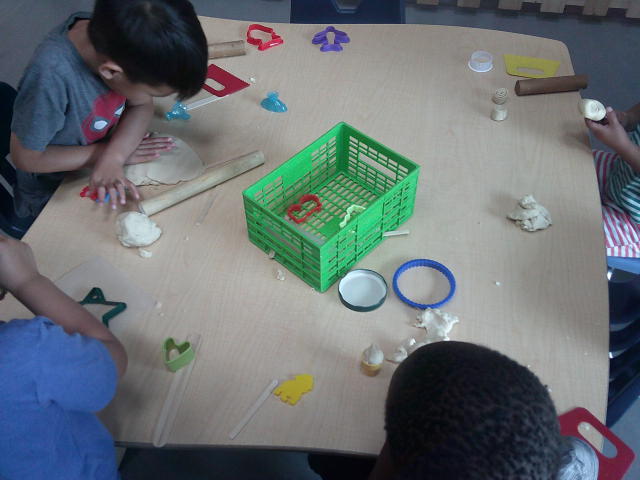
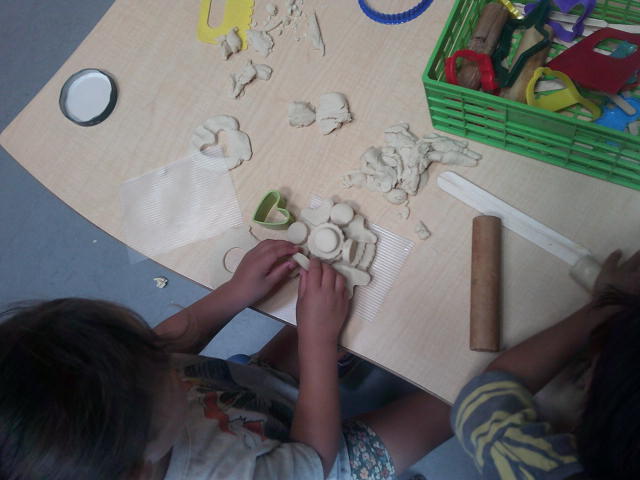
Date: July 8, 2025
Willows Room, Cariboo Childcare Society
This photo captured four children gathered around a small table, each engaged in shaping colourful playdough. One child was rolling out a long “snake,” another was making tiny “cookies,” and a third carefully pressed a leaf into the dough to create a print. Their hands were busy, their voices full of excitement, and the table was scattered with playdough tools, cutters, and natural loose parts.
The children spent more than 20 minutes working with playdough without needing adult prompts. They discussed what they were making, shared tools, and even complimented one another’s creations. One child said, “Mine is a cake for my mom’s birthday!” Another child asked, “Can you help me make a rainbow?” I noticed that their fine motor skills were actively engaged—pinching, rolling, cutting, while also practicing communication and collaboration.
This experience helped me see how open-ended materials like playdough foster creativity, patience, and cooperation. I found it heartwarming to see how invested the children were in their work. Their confidence grew as they took pride in their creations. I was reminded of how play can be both soothing and empowering.
As an educator, I learned to resist the urge to “teach” and instead observe how the children were already teaching each other. I asked questions like, “How did you make that pattern?” and “What does it feel like when you press the leaf in?” These invited them to reflect on their own process and share knowledge with peers.
I asked an educator, “Do you usually guide them with ideas when they play with playdough, or just let them explore?”
She said, “We let them lead. Playdough is one of those materials that invites children to take charge. If they ask for help or ideas, we step in gently. But mostly, it’s about trusting their creativity.”
Her response reminded me that silence and space can be powerful teaching tools.
Well-being and Belonging: The children felt safe and confident to express themselves creatively. Their laughter and cooperation revealed a strong sense of belonging.
Communication and Literacies: They used storytelling, descriptive language, and peer collaboration while naming their creations and explaining their process.
Spaces, Materials, and Time: The playdough and natural materials served as meaningful provocations for sensory and expressive learning.
This was a strong example of responsive curriculum. The children guided the direction of play, and I practiced pedagogical narration by observing and listening closely to how they explored form, texture, and imagination. Next time, I’d like to revisit this moment by setting up a “bakery” play area or bringing in cookbooks and measuring tools to extend the learning in different directions.
This aligns with the Code’s principle to “create and maintain safe and healthy environments” and to “engage with children as capable and creative learners.” By allowing uninterrupted exploration, I respected the children’s agency and creative choices.
Child Development: Supported fine motor development, sensory exploration, and emergent literacy through hands-on play.
Curriculum: Engaged in child-led inquiry that honoured children’s interests and developmental needs.
honoured Relationships: Built trust by showing interest in each child’s work, asking reflective questions, and celebrating their ideas.
This moment echoed our class discussions about “loose parts” and how sensory materials can spark inquiry and imagination. According to the BC ELF (2019), “Children make meaning through their engagement with materials, people, and the world around them.” This day was a clear example of that truth in action.
Reference
British Columbia Ministry of Education and Child Care. (2019). British Columbia Early Learning Framework (2nd ed.). https://www2.gov.bc.ca/gov/content/education-training/early-learning/teach/early-learning-framework
Early Childhood Educators of BC. (2004). Code of Ethics. https://www.ecebc.ca/resources/pdf/Ethics%20Booklet.pdf$CoMmEnt
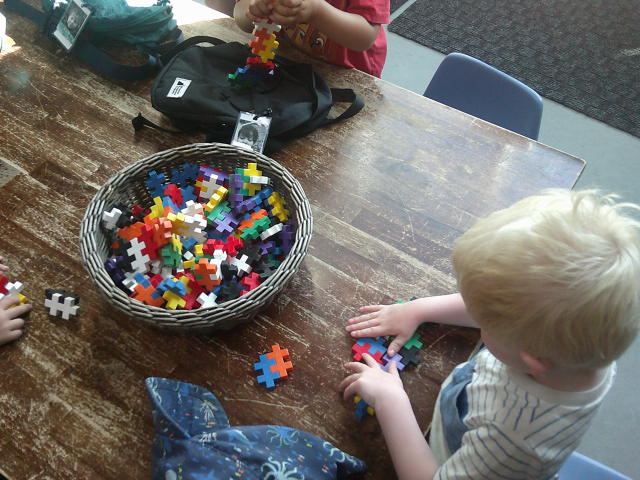
📅 Date: July 9, 2025
📍 Willows Room – Cariboo Childcare Society
In this photo, three children are seated, surrounded by a scattered pile of colourful, cross-shaped interlocking toys. These plastic pieces weren’t typical building blocks; they had little edges and grooves that allowed them to connect in many directions, kind of like puzzle pieces. The children were quietly working together to build a long, winding structure that stretched across the table. One of them said, “Let’s make it like a road!” while the others added their pieces with care.
I noticed how each child took a unique role, one child focused on sorting by colour, another handled connecting the longer lines, and the third filled in gaps. There was very little verbal instruction; they seemed to understand each other’s rhythm. When the structure broke in one spot, one child quickly said, “I’ll fix it,” and gently reattached it, showing patience and coordination. The group worked smoothly together for over 25 minutes without needing adult help.
Watching these three children co-create reminded me how powerful cooperative play can be. They weren’t just “playing with toys,” they were planning, problem-solving, and building relationships. I admired how naturally they took turns and respected each other’s ideas. There was no argument, just quiet teamwork. It reminded me how children often communicate nonverbally through action and shared focus.
If I had stepped in, I might have interrupted that flow. Instead, I allowed the moment to unfold, then joined them later to ask about what they made. One child proudly said, “It’s a rainbow road!”—an idea I would’ve never guessed on my own.
I asked an educator, “Do they usually play so well together without direction?”
She responded, “Yes, especially when they’re given open-ended materials. These cross-pieces are one of their favorites because there’s no ‘right’ way to build. It lets them lead the play—and you’ll notice, the quieter ones often shine the most during this kind of activity.”
favourites
Well-being and Belonging: The children’s cooperation showed a strong sense of social connection and respect.
Engagement with Others, Materials, and the World: They used materials to explore space, patterns, and teamwork.
Communication and Literacies: Although they didn’t speak much, their gestures and shared goals communicated volumes.
This experience made me reflect on the value of open-ended materials, how they allow children to use creativity and solve problems without fixed expectations. These cross-like connectors encouraged abstract thinking and innovation. I also thought about how the physical design of materials can support different learning styles—some children liked sorting, while others liked the building. Next time, I’d offer more colours or shapes nearby and maybe set up a camera so the children can document their work too.
This moment aligns with the ethical responsibility to “create and maintain safe, healthy, and inviting environments.” By allowing uninterrupted cooperative play, I supported children’s social-emotional and cognitive development respectfully and responsively.
Curriculum: Honoured emergent play by observing and responding to children’s self-directed exploration.
Honoured Child Development: Supported cognitive flexibility, spatial reasoning, and teamwork.
Relationships: Promoted trust and mutual respect through quiet, respectful observation and later engagement.
Our course readings emphasize how open-ended play materials help children “construct their knowledge” (ELF, 2019). This activity reflected that well. As the ELF reminds us, materials don’t just serve a purpose; they carry meaning, possibility, and expression. The children used these unfamiliar cross-shaped toys to create their own world.
Reference
British Columbia Ministry of Education and Child Care. (2019). British Columbia Early Learning Framework (2nd ed.).
https://www2.gov.bc.ca/gov/content/education-training/early-learning/teach/early-learning-framework
Early Childhood Educators of BC. (2004). Code of Ethics.
https://www.ecebc.ca/resources/pdf/Ethics%20Booklet.pdf$CoMmEnt
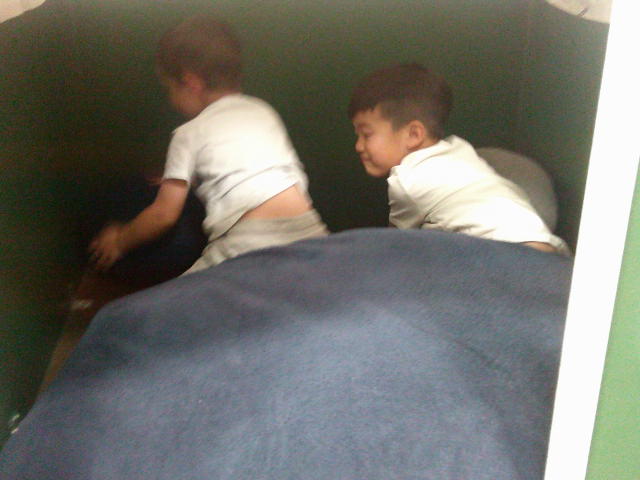
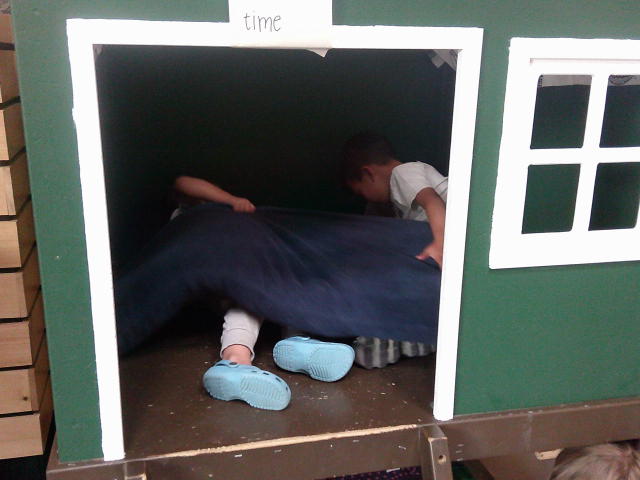
Date: July 10, 2025
Willows Room – Cariboo Childcare Society
In the first photo, two children are inside the playhouse area, gently smoothing out a small blanket on the doll bed. One child carefully fluffs a miniature pillow while the other folds the sheet. They giggle and talk softly about how they are “making the bed so it looks nice.” The second photo shows both children lying beside each other in the pretend bed, eyes closed, with slight smiles on their faces, pretending to sleep. One whispered, “Shhh, we’re sleeping like babies,” and the other responded, “Goodnight, friend.”
The two children worked in perfect harmony, showing respect for the materials and for each other’s ideas. They didn’t need prompting; it was as if they shared the same imagination. They took turns straightening the covers, smoothing the fabric. Their pretend sleeping included soft breathing sounds and hands folded gently, mimicking what they likely see during naptime. They remained in character for a surprising amount of time, over 10 minutes, before one sat up and said, “Time to wake up and eat breakfast.”
This moment reminded me how deeply children draw from their everyday routines and observations to guide their play. They weren’t just pretending; they were reliving a familiar ritual through care, calmness, and connection. What touched me most was the tenderness and teamwork between the two friends. There was no competitiveness, just shared joy in creating something together.
It also made me think about how pretend play allows children to process the world around them. By recreating naptime routines, they were perhaps soothing themselves or expressing feelings of comfort and friendship. Their “sleeping” moment wasn’t only sweet, it was emotionally rich and meaningful.
I asked the educator nearby, “Do they usually pretend sleep like this?”
She smiled and replied, “All the time! That’s their way of making sense of routines. It’s how they feel safe. You’ll notice they choose people they trust to do this kind of play, it’s very relational.”
Well-being and Belonging: The children created a shared experience rooted in comfort and care.
Identities, Social Responsibility, and Diversity: They demonstrated empathy and companionship.
Communication and Literacies: Their whispered dialogue and body language communicated peaceful connection.
This pretend-sleep scene wasn’t just cute; it showed how children emotionally process their day-to-day life through play. Their coordinated actions and mutual care reflect an internalization of routine and emotional safety. Next time, I’d consider adding small lamps or soft music in the playhouse to enrich this kind of nurturing dramatic play. Also, I might gently ask questions like, “What happens next after you wake up?” to extend their storyline without disrupting it.
This experience connects to the ethical principle of “valuing caring and collaborative relationships.” I honoured their space by observing quietly, recognizing the importance of trust and imagination in early childhood play.
Child Development: Supported emotional regulation and expressive skills.
Curriculum: Valued emergent play that reflects daily rhythms.
Relationships: Nurtured mutual respect and social bonding.
According to the BC Early Learning Framework (2019), play is “a space for children to express their inner worlds.” This experience reflected that beautifully. The children weren’t taught this—they lived it. The framework reminds educators to recognize the learning in every gentle interaction, especially ones rooted in love and care.
Reference
British Columbia Ministry of Education and Child Care. (2019). British Columbia Early Learning Framework (2nd ed.).
https://www2.gov.bc.ca/gov/content/education-training/early-learning/teach/early-learning-framework
Early Childhood Educators of BC. (2004). Code of Ethics.
https://www.ecebc.ca/resources/pdf/Ethics%20Booklet.pdf$CoMmEnt
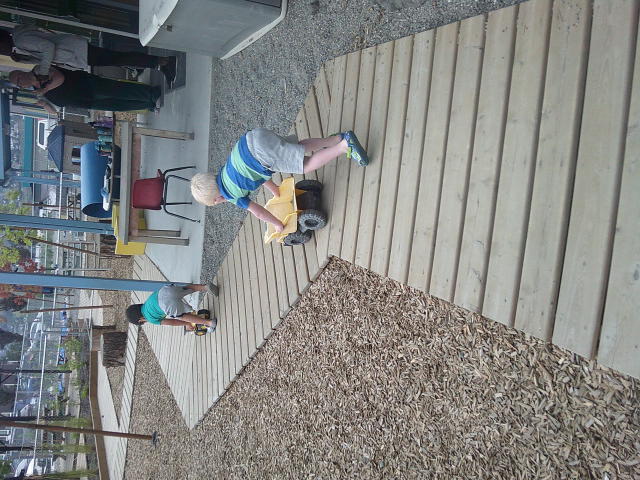
📅 Date: July 15, 2025
📍 Willows Room – Cariboo Childcare Society
In the photo, two children are outdoors on the paved walkway, each joyfully pushing a ride-on toy that resembles a small plastic tractor. One child zooms past, shouting “Vroom vroom!” while the other follows, pretending to beep a horn. Both have wide smiles and seem fully immersed in their pretend race. Their feet move quickly. The sunny weather added to the cheerful energy of the moment.
These two children played side by side for nearly 20 minutes, racing their toy tractors, taking turns pretending to fuel them up, and even creating imaginary destinations. At one point, one said, “Let’s drive to grandma’s house,” and the other responded, “Okay, but stop for gas!” They laughed freely and created sound effects with their mouths. There was no conflict, just mutual enjoyment and fast-paced play.
side by side.
This simple activity showed me how even unstructured outdoor time can be deeply meaningful and filled with learning. The children used movement, imagination, and cooperation all at once. What stood out to me was how they naturally built a story together through shared dialogue and body language. Their pretend driving became a mini-world of its own, full of role-play, speed, and creativity.
I asked one educator, “Do they always play like that when they’re outside?”
She answered, “Yes! Especially when they have something to ride. These toys give them a sense of freedom and control, and they start creating whole adventures. It’s also great for coordination and social interaction.
Well-being and Belonging: Outdoor play supported physical confidence and social connection.
Identities, Social Responsibility, and Diversity: The children negotiated space, shared the walkway, and imagined roles (drivers, travellers).
Communication and Literacies: Their storytelling and use of symbolic gestures (gas station, honking) reflected literacy in action.
What seemed like a fun race was a complex web of skills: physical coordination, imaginative thinking, social turn-taking, and even emotional expression. They trusted each other to stay in character and respected the “rules” they invented. Next time, I might bring in simple props like road signs or chalk to extend their storytelling further and support deeper pretend play.
This experience connects with the principle of respecting “children as capable learners.” I witnessed how, when left to their own pace and tools, children naturally build their joyful curriculum.
Child Development: Encouraged large motor development and independence.
Health, Safety, and Well-being: Supported safe, energetic play in a supervised outdoor environment.
Relationships: Fostered collaborative play without adult interference.
The BC Early Learning Framework (2019) emphasizes the value of outdoor environments as “spaces of possibility and exploration.” Today’s play supported that idea, outdoors became a world of roads, destinations, and speed. Their laughter and imagination filled the space and reflected the kind of engagement that can’t be forced, only allowed.
Reference
British Columbia Ministry of Education and Child Care. (2019). British Columbia Early Learning Framework (2nd ed.).
https://www2.gov.bc.ca/gov/content/education-training/early-learning/teach/early-learning-framework
Early Childhood Educators of BC. (2004). Code of Ethics.
https://www.ecebc.ca/resources/pdf/Ethics%20Booklet.pdf
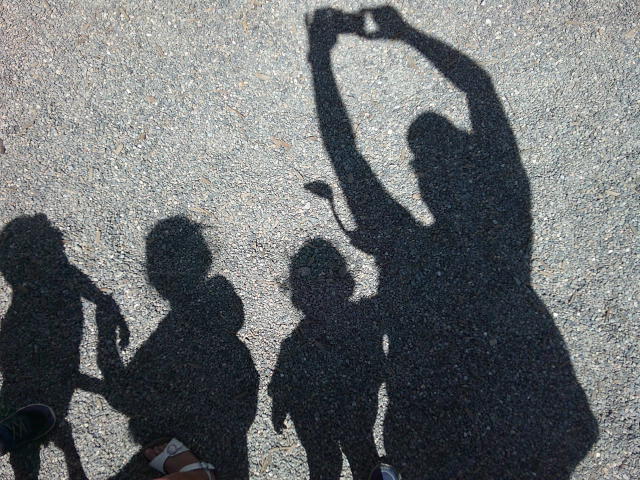
Date: July 16, 2025
Willows Room, Cariboo Childcare Society
In this photo, the shadow of my body and the shadows of three children appear clearly on the pavement outdoors. One of the children is holding a big plastic spoon he had been using to scoop sand. The other two girls stood beside him. Initially, they approached me and asked, “Can you take a picture with your camera?” But before I could take it, they noticed my shadow and began giggling and pointing to the ground, trying to find their own. That small discovery sparked excitement, and they insisted we take a “shadow picture” instead. After snapping the photo, I showed them, and their laughter was so pure, they were thrilled to see their outlines on the screen.
This interaction lasted no more than five minutes but was rich in imagination and sensory experience. They pointed, waved, and experimented with different poses. One said, “Look! Mine looks like a giant!” while another shouted, “Where’s my face?” They crouched, jumped, and stretched their arms, amazed by how the shadows mimicked them. What started as a simple picture request turned into a collaborative exploration of light, movement, and perspective.
This experience reminded me how much learning comes from following the children’s lead. I never expected a lesson in shadows, yet it unfolded naturally. Their curiosity transformed an ordinary moment into one full of wonder. I was especially touched by how inclusive they were; no one took over or pushed anyone aside. They simply explored together and celebrated their discovery. It made me reflect on how sometimes the most meaningful learning isn’t planned; it just happens when you’re present and open.
I asked an educator, “Do they often notice things like shadows when they’re playing?
She smiled and replied, “All the time. They see things we adults overlook. Shadows, bugs, cracks in the sidewalk, it’s how they connect with the world. When we give them the space to explore these little things, we help them build scientific thinking without even calling it science.
Exploration and Creativity: Children investigated how light and shadow interact, experimenting with body positions and angles.
Well-being and Belonging: They initiated the moment and found joy in being seen, heard, and included.
Communication and Literacies: They used verbal language, gestures, and body movement to express excitement and ideas.
This day taught me to slow down and pay attention to the subtle moments. What appeared to be just “shadow play” was a meaningful learning encounter. They developed observational skills, spatial awareness, and social engagement, all sparked by natural curiosity. If I had dismissed their request or rushed the moment, this learning might not have happened. Next time, I might bring chalk and explore tracing shadows to deepen the experience.
This moment reflects the ethical commitment to “value and nurture the uniqueness and potential of each child.” I followed their lead, listened to their ideas, and supported their joyful discovery.
Child Development: Supported emergent exploration in a natural environment.
Health, Safety, and Well-being: Children engaged safely outdoors while developing cognitive and emotional skills.
Play-based Learning: Fostered curiosity-led play with no adult direction.
The BC Early Learning Framework (2019) encourages educators to see the child as “capable of complex thinking” and highlights the value of noticing what children notice. Today’s moment was a perfect example, an unplanned observation of shadows led to collaborative play, science inquiry, and connection.
Reference
British Columbia Ministry of Education and Child Care. (2019). British Columbia Early Learning Framework (2nd ed.).
https://www2.gov.bc.ca/gov/content/education-training/early-learning/teach/early-learning-framework
Early Childhood Educators of BC. (2004). Code of Ethics.
https://www.ecebc.ca/resources/pdf/Ethics%20Booklet.pdf
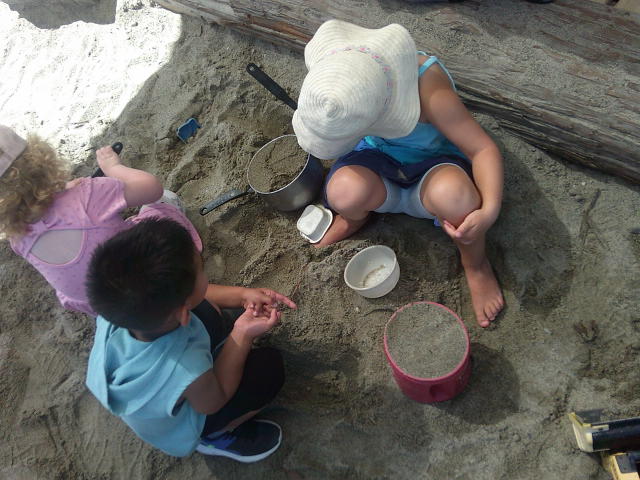
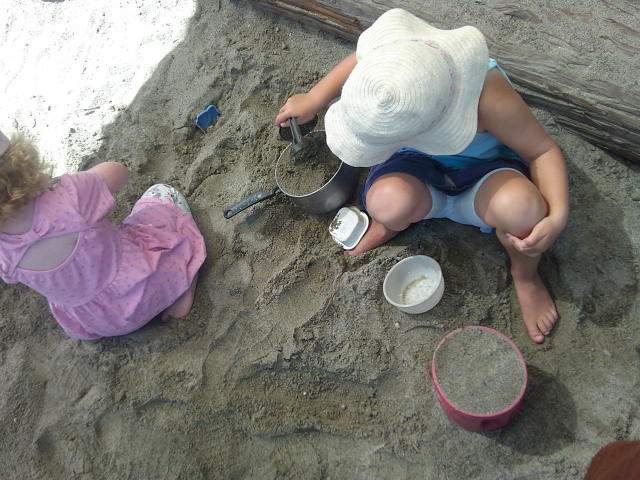
Date: July 17, 2025
Willows Room, Cariboo Childcare Society
In this photo, a group of children is in the sandbox outdoors. They are completely absorbed in pretend cooking. Using their small rubber containers and pots, they filled them with a mixture of wet sand and water, creating what they called their “meal.” Some used sticks as cooking spoons, while others stirred and served their creations to each other, giggling with pride. Their hands were messy, their faces joyful, and their conversation flowed like they were chefs in a busy kitchen.
As I approached, one of the children said, “We’re making soup!” Another added, “Mine is cake. Don’t eat it yet, it’s still hot!” They worked together, shared tools, and invited each other to sample their sandy meals. I noticed how focused they were, not distracted by anything else around them. One boy carefully pressed sand into the pot and poured water slowly to get the “perfect mix.” Another child even said, “You have to wait. It’s not ready yet.”
This experience reminded me of how powerful pretend play is in early learning. They weren’t just playing, they were collaborating, communicating, and problem-solving. I didn’t need to interrupt or guide them. My role was simply to observe, appreciate, and encourage. I also noticed how sensory-rich the activity was: the feel of wet sand, the resistance of stirring, the balancing of water. It was messy, yes, but beautifully meaningful. Their creativity, social bonding, and joy in the process stayed with me long after.
I asked an educator nearby, “Do you encourage this kind of messy play every day?”
She smiled and said, “Absolutely. It helps with everything, fine motor skills, emotional expression, and even early math and science. And they love it. We just make sure they’re dressed for mess and let them explore.”
Well-being and Belonging: Children felt safe and free to explore together, supporting each other in imaginative ways.
Engagement with the World: They engaged deeply with natural materials (sand, water, tools) in the outdoor space.
Communication and Literacies: Through pretend language and expressive gestures, they practiced storytelling and social conversation.
Exploration and Creativity: Inventing meals from natural elements showed high-level imaginative thinking and experimentation.
This moment reminded me that children are natural creators when given the right materials and space. Their pretend cooking reflected real-life knowledge and a desire to imitate, imagine, and share. The wet sand acted like clay, moldable, sensory, and satisfying. I was struck by how seriously they took their roles as chefs. If we had interrupted or moved them too quickly, this rich social-emotional moment would have been lost. Next time, I may extend this by offering more loose parts, like leaves, pebbles, or cardboard, as extra “ingredients”
This moment honors the ethical principle to “create and maintain safe and healthy environments that support the optimal development of children.” Encouraging sensory-rich, imaginative, and cooperative play shows respect for children’s learning processes.
Play-based Learning Supports emergent play rooted in creativity and collaboration.
Health, Safety, and Well-being: Provided a safe, responsive environment for outdoor exploration.
Child Development: Promoted cognitive, emotional, and social development through pretend and sensory play.
The BC Early Learning Framework (2019) discusses “co-constructing meaning through play,” and today’s sandbox scene was a perfect example. The children’s actions were not random; they were structured, intentional, and meaningful, even without adult direction.
Reference
British Columbia Ministry of Education and Child Care. (2019). British Columbia Early Learning Framework (2nd ed.).
https://www2.gov.bc.ca/gov/content/education-training/early-learning/teach/early-learning-framework
Early Childhood Educators of BC. (2004). Code of Ethics.
https://www.ecebc.ca/resources/pdf/Ethics%20Booklet.pdf
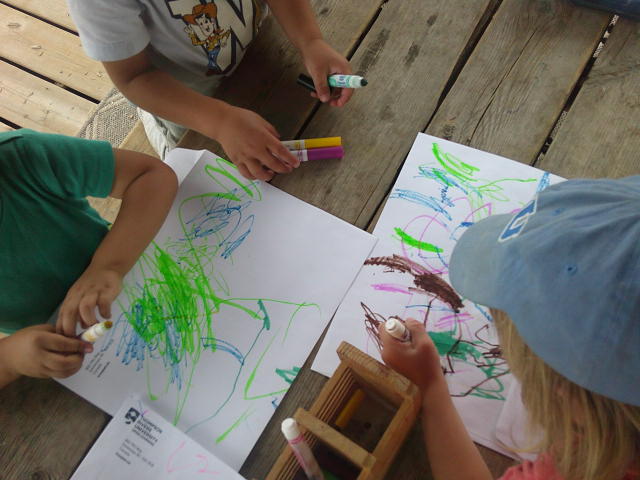
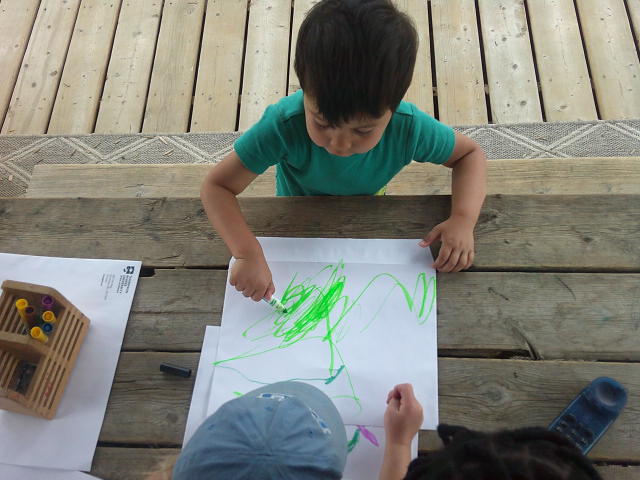
Date: July 18, 2025
Willows Room, Cariboo Childcare Society
In this photo, children are seated around a table with plain white sheets of paper in front of them. Each child holds a coloured pen, red, blue, green, purple, and is completely engaged in scribbling, doodling, and exploring the marks they can make. The table is filled with quiet excitement as each child focuses on their paper, occasionally glancing at their friend’s creation. Their faces lit up every time they switched colours, joyfully showing off their drawings, even if they were simple lines or circles.
One child giggled and said, “Look, rainbow lines!” while another carefully changed pen colours after every few strokes. A third child proudly held up her paper and said, “This is my house.” I noticed a range of expressions: concentration, curiosity, and pride. No one needed instruction, just the tools and the freedom to explore. They swapped pens among themselves, pointing at the ones they liked. The energy was calm but joyful, and each child was fully immersed in their creative process.
Watching the children freely express themselves reminded me of the value of open-ended materials in early learning. These were not structured colouring sheets; they were blank pages that allowed the children to be authors and illustrators of their worlds. I realized how something as simple as a pen and paper could spark self-confidence, storytelling, and even early writing skills. This activity also supported fine motor development and encouraged peer-to-peer interaction as they admired and shared each other’s work. I learned that creativity doesn’t require elaborate, just freedom and support.
I asked an educator, “Do you usually give them plain paper instead of colouring books?”
She responded, “Yes, we prefer open-ended drawing. It gives them the freedom to create anything, not just stay within lines. You’ll be surprised what stories come out when you ask them about their pictures.”
Communication and Literacies: Children were experimenting with early writing and visual expression, sharing their ideas through drawings.
Well-being and Belonging: Each child took pride in their creation and felt safe to share it with peers and educators.
Exploration and Creativity: Through self-directed drawing, children explored lines, colours, and shapes in their own unique ways.
This experience deepened my understanding of how children use art to process thoughts and emotions. One child’s scribble might seem random to an adult, but to them, it could represent something deeply meaningful. Instead of interpreting for them, I learned to ask, “Tell me about your picture,” and their responses always surprised me. This respectful approach not only values their voice but supports the development of narrative thinking and confidence. Next time, I might offer other tools like crayons or stamps to extend their creative experience.
This moment aligns with the ethical responsibility to “foster self-esteem and a sense of belonging in children.” By encouraging children’s free artistic expression, we affirm their ideas and identities.
Child Development: Supported cognitive, emotional, and fine motor growth.
Play-based Learning: Offered materials that encouraged independent creativity and exploration.
Inclusive Practices: Honoured every child’s unique way of expressing themselves.
The BC Early Learning Framework (2019) emphasizes that “expression in multiple forms, including drawing, builds children’s sense of self and communication.” Today’s drawing activity embodied this principle beautifully.
Reference
British Columbia Ministry of Education and Child Care. (2019). British Columbia Early Learning Framework (2nd ed.).
https://www2.gov.bc.ca/gov/content/education-training/early-learning/teach/early-learning-framework
Early Childhood Educators of BC. (2004). Code of Ethics.
https://www.ecebc.ca/resources/pdf/Ethics%20Booklet.pdf
